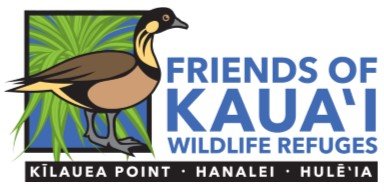
Wetland Birds of Hanalei & Hulēʻia NWR
-

HAWAIIAN GOOSE – NĒNĒ
Hawaii’s state bird, the nēnē, is a threatened species and considered to be the rarest goose in the world. Re-introduction efforts, coupled with good management practices on the refuge and throughout the islands, are helping to increase the population. Kīlauea Point NWR was the location of one of the first re-introduction efforts on Kauaʻi in the 1990’s and, since that time, the population on the refuge has grown steadily. Visitors out to the Point are regularly treated to up-close views of nēnē and, during the breeding season, even their goslings too. Nēnē can be found on all three refuges of the Kauaʻi National Wildlife Refuge Complex, and across Kauaʻi.
YEAR ROUND - ALL 3 REFUGES
STATUS: THREATENED -

HAWAIIAN DUCK – KOLOA
The Hawaiian duck, also known as koloa or koloa maoli, is an endemic and endangered duck species in Hawaiʻi. Koloa are generally seen in pairs and are fairly wary of people. Both the male and the female koloa have a mottled brown coloration that resembles that of a female mallard which a species of duck introduced to Hawaii and gone feral. Studies at the Hanalei refuge showed that some of the koloa found on the refuge made a daily flight between Hanalei and as high up as the Alakaʻi swamp. Conservationists are concerned about koloa interbreeding with the introduced mallards and compromising the genetic integrity of this native species. Like all the other endemic waterbirds in Hawaii, loss of wetland habitat and introduced predators have been the significant cause of population decline and subsequent listing as an endangered species.
YEAR ROUND
STATUS: ENDANGERED -
HAWAIIAN STILT – AEʻO
The aeʻo has the second longest legs, after the flamingo, in relation to body size, of any other bird. The long beak give a hint as to how the stilt feeds, which is to probe into the mud for insects, crabs and other invertebrates. The aeʻo nests on mudflats and on the banks of the kalo patches and ponds. Stilts are very protective of their nests. They will swoop at predators and sometimes feign an injury, calling out as if wounded and limping away from the eggs or young. This act cleverly lures potential predators away.
YEAR ROUND
STATUS: ENDANGERED -
HAWAIIAN GALLINULE – ʻALAE ʻULA
The Common or Hawaiian Gallinule (formerly the Moorhen), also called ʻalae ʻula in Hawaiian, is really not so common after all. This endangered waterbird is endemic to Hawaiʻi and though considered to be common in the 1800s, it is now only found on Kauaʻi and Oahu. It is quite secretive but can be seen at Hanalei NWR and other wetlands or along ditches on Kauaʻi. In Hawaiian mythology, ʻalae ʻula is attributed with bringing fire from the realm of the gods to the Hawaiian people. It was said to have been scorched on the forehead in the process of doing so, thus the bright red bill and forehead.
YEAR ROUND
STATUS: ENDANGERED -
HAWAIIAN COOT – ʻALAE KEʻOKEʻO
The Hawaiian coot, known as ʻalae keʻokeʻo, is another of the endangered waterbird species that lives at Hanalei and Hulēʻia NWRs. This dark, slate gray bird with white bill and forehead shield spends more of its time in open water areas compared to its more secretive relative, the Hawaiian Moorhen or ʻalae ʻula.
YEAR ROUND
STATUS: ENDANGERED -
BLACK-CROWNED NIGHT HERON – ʻAUKUʻU
This large (2 feet tall) dark and light gray waterbird is indigenous to Hawaiʻi and is found on all the main Hawaiian Islands. The ʻaukuʻu is a stealthy hunter feeding on fish, mice, crustaceans, insects and the chicks of other waterbirds as well. Though most commonly seen in freshwater habitats, it can also be seen hunting in tide pools and exposed reefs during low tides.
YEAR ROUND





